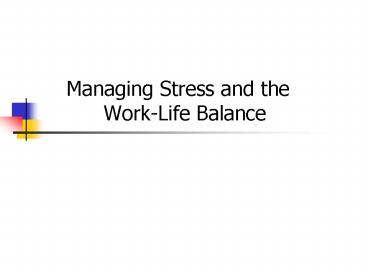Managing Stress and the WorkLife Balance - PowerPoint PPT Presentation
1 / 17
Title:
Managing Stress and the WorkLife Balance
Description:
The pleasurable stress that accompanies positive events. For example, a person may receive a $5,000 bonus and experience stress deciding ... – PowerPoint PPT presentation
Number of Views:6948
Avg rating:3.0/5.0
Title: Managing Stress and the WorkLife Balance
1
- Managing Stress and the Work-Life Balance
2
Stress Defined
Stress is a persons adaptive response to a
stimulus that places excessive psychological or
physical demands on that person.
3
The General Adaptation Syndrome
- The General Adaptation Syndrome, or GAS,
describes three stages of the stress process - Stage 1 Alarm
- Stage 2 Resistance
- Stage 3 Exhaustion
4
Distress and Eustress
- Eustress
- The pleasurable stress that accompanies positive
events. For example, a person may receive a
5,000 bonus and experience stress deciding how
to spend the money. - Distress
- The unpleasant stress that accompanies negative
events.
5
Individual Differences and Stress
Stress can affect different people in different
ways. The most fully developed individual
difference relating specifically to stress is the
distinction between Type A and Type B personality
profiles.
6
Type A and Type B Personality Profiles
Type B
Type A
The Type A individual is extremely competitive,
very devoted to work, and has a strong sense of
time urgency.
The Type B person is less competitive, is less
devoted to work, and has a weaker sense of time
urgency.
vs.
7
Hardiness
- Hardiness
- A persons ability to cope with stress.
- People with hardy personalities have an internal
locus of control, are strongly committed to the
activities in their lives, and view change as an
opportunity for advancement and growth.
8
Optimism
- Optimism
- The extent to which a person sees life in
relatively positive or negative ways. - Is the glass half empty or half full?
- In general, optimistic people tend to handle
stress better than pessimistic people.
9
Common Causes of Stress
Two broad categories of stressors are
organizational stressors and life stressors.
Three categories of stress consequences are
individual consequences, organizational
consequences, and burnout.
10
Causes of Stress Organizational Stressors
Task Demands - Occupation - Security - Overload
Role Demands - Ambiguity - Conflict
Physical Demands - Temperature - Office Design
Interpersonal Demands - Group Pressures -
Leadership Style - Personalities
11
Life Stressors
Life Change
Life Trauma
12
Consequences of Stress Individual Consequences
Behavioral - Alcohol Abuse - Drug Abuse -
Violence
Psychological - Sleep Disturbances - Depression
Medical - Heart Disease - Headaches
13
Organizational Consequences
Decline in Performance
Absenteeism and Turnover
Decreased Motivation and Satisfaction
14
Consequences of Stress Burnout
Burnout is the general feeling of exhaustion that
develops when an individual simultaneously
experiences too much pressure and has too few
sources of satisfaction.
15
Managing Stress in the Workplace
Individual Coping Strategies
Exercise
Relaxation
Time Management
Role Management
Support Groups
16
Managing Stress in the Workplace
Organizational Coping Strategies
Institutional Programs
Collateral Programs
17
Work-Life Linkages
Work-life relationships include relationships
between dimensions of the persons work life and
the persons personal life. Balancing work-life
linkages is, of course, no easy thing to do.































